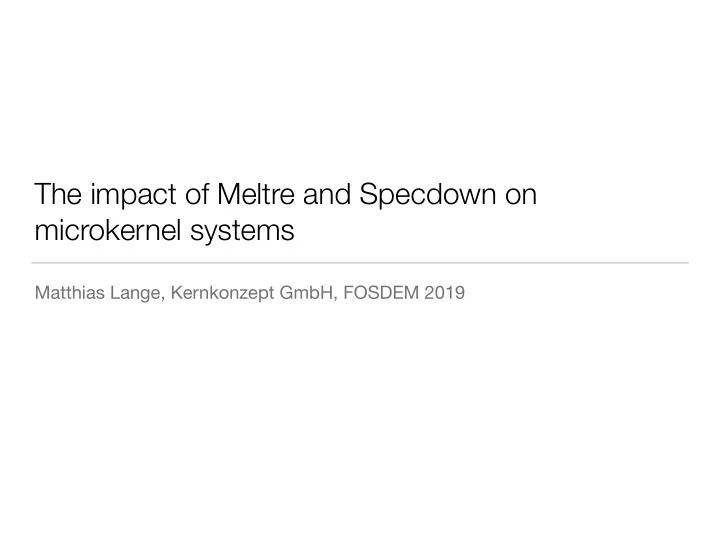

The impact of Meltre and Specdown on microkernel systems Matthias Lange, Kernkonzept GmbH, FOSDEM 2019
“We need to talk about Meltre and Specdown.” –Conf call with customer, early 2018
The impact of Meltdown and Spectre on the L4Re microkernel system
Questions • Where we prepared? • Did microkernel design principles protect or help us? • What’s the impact of implemented mitigations?
Questions - Spoiler • Where we prepared? No • Did microkernel design principles protected or helped us? A little bit 😦 • What’s the impact of implemented mitigations?
Meltdown & Spectre Set of vulnerabilities in modern CPUs
Meltdown
Classic virtual address space layout 4 GB Kernel 3 GB User 0
Classic virtual address space layout 4 GB Kernel 1:1 3 GB User 0
L4Re’s virtual address space layout • Fiasco reserves fixed amount of memory for itself • Not all physical memory is mapped in the kernel • Uses big pages for mapping • Mapping may include user memory
L4Re’s virtual address space layout 4 GB Kernel 1:1 3 GB User 0
Solution: Kernel address space • Move kernel into its own address space • Fiasco uses a CPU local address space • User address space only maps absolutely necessary parts • GDT, TSS, entry / exit stack, UTCBs
Benchmarks - PTI
Benchmarks - Meta • Baseline • Fiasco GitHub commit 566cc120, January 1st, 2018 • Head • Fiasco GitHub commit 591c8c0b, January 7th, 2019 • Compiler: kernel clang 6, userland gcc 7.3 • Core i7-5700EQ, 2.60GHz • Contact me if interested in raw data
Benchmarks - Scenario 1 iperf3 iperf3 L4Linux L4Linux L4Re Microkernel
Benchmarks - Scenario 2 iperf3 iperf3 L4Linux L4Linux virtio p2p link L4Re Microkernel
Micro benchmarks - pingpong, PTI Baseline 2018 PTI 4000 3.371 3000 2.586 2000 1.759 1.561 1000 963 422 0 IPC inter AS Context switch Thread switch (intra)
Benchmarks - Scenario 1, PTI Baseline 2018 PTI 10 9,37Gbit/s 9,27Gbit/s 7,5 5 2,5 0 iperf3
Benchmarks - Scenario 2, PTI Baseline 2018 PTI 6 5,14Gbit/s 4,5 3 3,17Gbit/s 1,5 0 iperf3
Spectre
Spectre • Indirect branch prediction speculatively access data causing side effects
Spectre NG • Speculative access to FPU state while current context is not the owner • Fiasco uses lazy FPU switching
Spectre NG - Mitigation • Fiasco now supports eager switching on x86 • Does this incur any performance loss?
Benchmarks - Eager FPU switching
Micro benchmarks - pingpong, PTI, eager FPU Baseline 2018 PTI PTI, eager FPU 4000 3.729 3.371 3000 2.918 2.586 2000 1.759 1.561 1.149 1000 963 422 0 IPC inter AS Context switch Thread switch (intra)
Benchmarks - Scenario 1, PTI, eager FPU Baseline 2018 PTI PTI, eager FPU 10 9,37Gbit/s 9,27Gbit/s 9Gbit/s 7,5 5 2,5 0 iperf3
Benchmarks - Scenario 2, PTI, eager FPU Baseline 2018 PTI PTI, eager FPU 6 5,14Gbit/s 4,5 3 3,17Gbit/s 3,12Gbit/s 1,5 0 iperf3
Spectre continued • Most variants do not work across process boundaries • Usually code execution required
Spectre continued - Mitigations • Fiasco mitigations • Indirect branch prediction barrier at kernel entry • Full prediction barrier at context switch • (microcode loading functionality)
😦 Benchmarks - IBRS
Micro benchmarks - pingpong, IBRS Baseline 2018 PTI PTI, eager FPU PTI, IBRS, eager FPU 18000 16.601 13500 9000 8.820 4500 3.729 3.371 2.918 2.638 2.586 1.759 1.561 422 963 1.149 0 IPC inter AS Context switch Thread switch (intra)
Benchmarks - Scenario 1, IBRS Baseline 2018 PTI PTI, eager FPU PTI, IBRS, eager FPU 10 9,37Gbit/s 9,27Gbit/s 9Gbit/s 7,5 7,68Gbit/s 5 2,5 0 iperf3
Benchmarks - Scenario 2, IBRS Baseline 2018 PTI PTI, eager FPU PTI, IBRS, eager FPU 6 5,14Gbit/s 4,5 3 3,17Gbit/s 3,12Gbit/s 1,5 1,28Gbit/s 0 iperf3
Foreshadow L1 Terminal Fault
L1 Terminal Fault • Affects OS / SMM, VT-x and SGX • SGX not supported in L4Re • Don’t care • SMM needs to protect itself
L1 Terminal Fault - L4Re mitigations • OS • Fiasco is not vulnerable • We zero our PTEs • VT-x is nasty • Microcode update • New MSR and new instruction for L1D flush • Flush L1D on every vmresume
Benchmarks - Sorry, no benchmarks for L1TF.
But there is one more thing …
One more thing • All features / mitigations are configurable • You can turn off • PTI • Eager FPU • IBRS • How does this compare to the 2018 baseline?
Micro benchmarks - pingpong Baseline 2018 PTI PTI, eager FPU PTI, IBRS, eager FPU Baseline 2019 18000 13500 9000 4500 0 IPC inter AS Context switch Thread switch (intra)
Micro benchmarks - pingpong Baseline 2018 Baseline 2019 PTI PTI, eager FPU 4000 3.729 3.371 3000 2.918 2.586 2000 1.759 1.733 1.561 1.422 1.149 1000 963 422 425 0 IPC inter AS Context switch Thread switch (intra)
Benchmarks - Scenario 1 Baseline 2018 Baseline 2019 PTI PTI, eager FPU 10 9,37Gbit/s 9,29Gbit/s 9,27Gbit/s 9Gbit/s 7,5 5 2,5 0 iperf3
Benchmarks - Scenario 2 Baseline 2018 Baseline 2019 PTI PTI, eager FPU 6 5,14Gbit/s 5,14Gbit/s 4,5 3 3,17Gbit/s 3,12Gbit/s 1,5 0 iperf3
Conclusion
“Fiasco is still not the fastest microkernel in the world.” – Me
Conclusion • Some bugs did not hit as hard • “missing” features helped us • Dramatic performance impact • Consider alternatives compared to microcode • Reconsider existing legacy implementations • Removed IO page fault • What to expect in the future? How can we proactively act? • gcc vs. clang
Recommend
More recommend